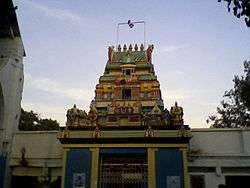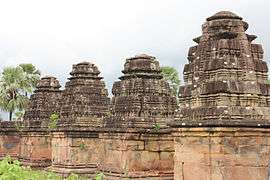Thousand Pillar Temple
| Thousand Pillar Temple | |
|---|---|
|
1000 pillar temple | |
 Thousand Pillar Temple Location in Telangana State  Thousand Pillar Temple Location in Telangana State | |
| Name | |
| Proper name | Thousand Pillar Temple |
| Telugu | వెయ్యి స్తంభాల గుడి |
| Geography | |
| Coordinates | 18°00′13.4″N 79°34′29.1″E / 18.003722°N 79.574750°ECoordinates: 18°00′13.4″N 79°34′29.1″E / 18.003722°N 79.574750°E |
| Country | India |
| State | Telangana |
| Location | Hanamakonda, Warangal |
| Culture | |
| Primary deity | Shiva, Vishnu, Surya |
| Architecture | |
| Architectural styles | Kakatiya, Chalukya |
| History and governance | |
| Date built | 1163 AD |
| Creator | Rudra Deva |
The Thousand Pillar Temple or Rudreshwara Swamy Temple[1] is a historic Hindu temple located in the town of Hanamakonda, Telangana State, India.[2] It is dedicated to Shiva, Vishnu and Surya.
Thousand Pillar Temple, along with "Warangal Fort" and "Ramappa Temple" are added to the tentative list of World Heritage sites recognised by UNESCO.[3]
History
Many Hindu temples were developed under the patronage of Ganapati Deva, Rudrama Devi and Prataparudra of Kakatiya dynasty. The Thousand Pillar Temple was believed to be constructed during the period between 1175–1324 CE by order of the king, Rudra Deva. It stands out to be a masterpiece and achieved major heights in terms of architectural skills by the ancient Kakatiya vishwakarma sthapathis.[4]
It was desecrated by the Tughlaq dynasty during their invasion of the Deccan.
Architecture
The Thousand Pillar Temple with its ruins lies near the Hanamkonda-Warangal Highway in Telangana State, about 150 kilometres (93 mi) from the city of Hyderabad.
The temple is star-shaped with several shrines and lingams. There are three shrines inside the temple called the Trikutalayam, dedicated to Shiva, Vishnu, and Surya. There are 1,000 pillars in the structure, but no pillar obstructs a person in any point of the temple to see the God. The temple is surrounded by a big garden in which many small lingam shrines can be seen. There is a carving of a Nandi bull in the form of a highly polished black basalt monolith.
The Thousand Pillar Temple is constructed on a platform that is raised to a height of 1 metre (3.3 ft) from ground level. Rock-cut elephants and perforated screens in the temple are characteristic of the then prevailing dynasty.
The temple was renovated in 2004 by the Government of India. Archaeological Survey of India and modern engineers have been working for the temple's further renovation.
Transport
A good transport facility is available to reach out to temple by road. The nearest railway station is Warangal railway station, which is 3 km away from the temple.
References
- ↑ "Thousand Pillar Temple History". Retrieved 6 March 2016.
- ↑ 1,000-pillar temple to get facelift - Times Of India. Articles.timesofindia.indiatimes.com (2003-07-20). Retrieved on 2013-08-25.
- ↑ Centre, UNESCO World Heritage. "The Glorious Kakatiya Temples and Gateways - UNESCO World Heritage Centre". whc.unesco.org. Retrieved 28 June 2016.
- ↑ http://www.templedetails.com/thousand-pillar-temple-warangal/
External links
| Wikimedia Commons has media related to Thousand Pillar Temple. |



